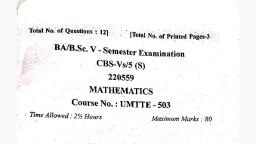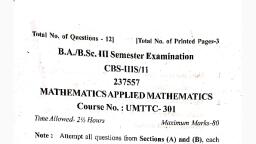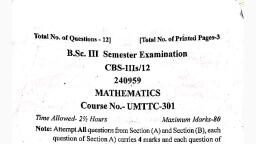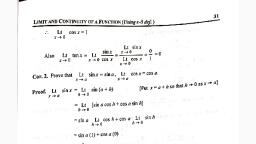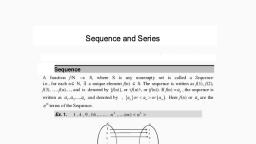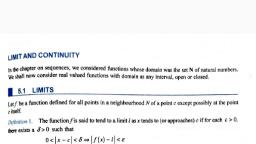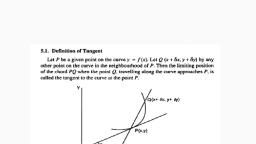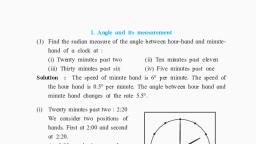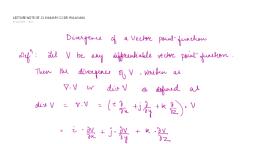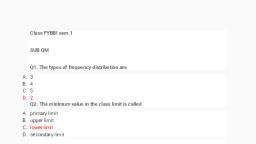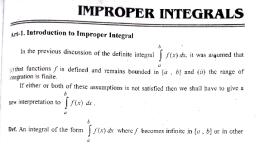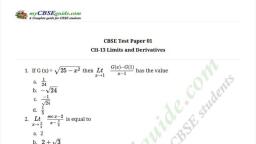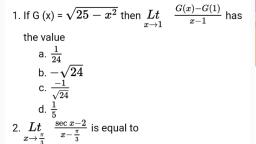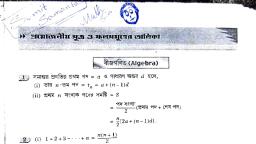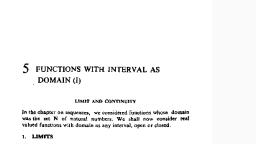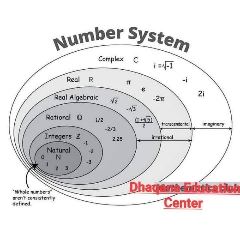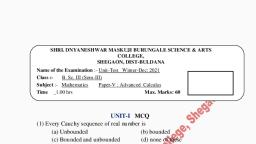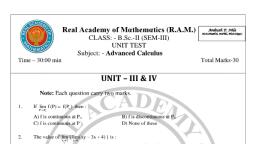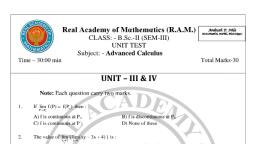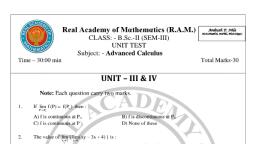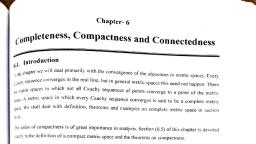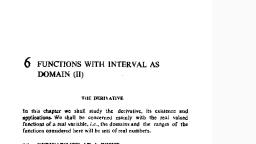Page 1 :
SYLLABUS, , SEMESTER-I, DIFFERENTIAL CALCULUS, , Course Number : UMTTC101, , , , , , , , , , , , Internal Assessment Test : 20 Marks Credits £06., , External End Semester University Examination : 80 Marks, (For the Examinations to be held in Dec. 2019, 2020 and 2021), Unit-I, , Concept of Limit and Continuity of functions on R (¢-6 definition) |, , Algebra of Limits, Discontinuity and types of Discontinuities, Successive., differentiation, Leibnitz Theorem. Indeterminate Forms. Examples and, , Exercises based on these topics., Unit-I, Functions of two and three variables : Continuity of functions in two, real variables. Partial differentiation, Euler’s theorem for homogeneous, functions. Maxima and Minima of Functions of two variables. Concavity, of Functions. Examples and Exercise based on these topics., Unit-III, Asymptotes, Double points, Envelope, Curve Tracing in Cartesian, Co-ordinates. Examples and Exercise based on these topics,, Unit-IV, Polar co-ordinates, Relation between Cartesian and Polar ¢0, ordinates, Angle between radius vector and tangent to the curve. Graphing, , , , ial, a aia i eh 3
Page 2 :
Techniques in Polar forms such as r= a + b cos 6,r=a + b sin 6, r=asinn 8,, r=acosn@3;n=1, 2, 3 only. Examples and Exercise based on these i, topics., Unit-V, Rolle’s Theorem, The Mean Value Theorems, Taylors Theorem with, Lagrange’s and Cauchy’s form of remainder. Maclaurin’s Series of sin x,, , cos x, tanx, tan~'x,cot™!x e*, log (1 +x), (1+x)”. Examples and exercises, Ip:, , based on these theorems., , citar, , 4
Page 3 :
aa ee ee ee eee ee a Oe, , I, , LIMIT AND CONTINUITY OF A, FUNCTION (Using ¢-6 def.), , ————— es, , , , , , , , Art-1. Introduction, , Limits play a very important role in calculus. In fact, limits and continuity provide, the foundation for theory of calculus., , We have already discussed various types of functions and sketched their graphs. The, graphs of some functions are continuous i.e., without any break whereas, some of them, have shown discontinuous nature or have breaks at some of the points, e.g., sin x, COs x,, |x | have continuous graphs where [x], tan x, cot x, sec x, cosec x etc. are discontinuous, functions for all x. The behaviour of a function, that how smoothly graph of a function varies, near about a point of its domain is of great importance. Limit of a function helps us this course, , of study., Art-2. Neighbourhood of a Point, , Let c be any real number and a, b ER such that a <c <b then the open interval, (a, b) is called a neighbourhood of c. In other words, any open interval (a, b) containing, c € Ris called neighbourhood of c., , The size (or length) of a neighbourhood (a, 6) is measured by | 6 — a |. The, , neighbourhood (a, 5) is called symmetric neighbourhood of c iff | c- |= |c—6|. Thus for, agiven 6>0, (c—6,c+6)= {xER: |x-cl< 6} is called d-neighbourhood of c and is, , symmetrical about c., , Deleted neighbourhood, , Any neighbourhood of c not containing the point c is called a deleted neighbourhood, of c. Thus if c € (a, b), then (a, c) U (e, 6) isa deleted neighbourhood of c. The set, , {ER : 0<|x-<d}=(wER : [xc] <6 and xc}, =(c-6,c) U(c,¢+d)isa deleted neighbourhood of c., , One sided neighbourhood, Let ¢ be any real number and a,6 ER such that a<e¢<b then (a, c] is called a a, , left neighbourhood and [c, 5) is called a right neighbourhood of c. Similarly (¢ — 6, c], and [c, c + 4) are called left and right d-neighbourhood ofc, Also (c-0, c) and (¢, ¢ + 0), , are called left and right deleted d-neighbourhood of the point c. 4, , 1
Page 4 :
: SpeCIRUM DIFFERENTIAL Catcgy 1, , i, , , , , , , , , , , , Art-3. Meaning of x a(x approaches a), , ‘ ans there exists i, x ameans x # abut | x—afis very small. Sox > 4 mene 54 posit, , mumber 60, however small, such that 0-< [xa] <9, or x» €(a—d,a40) and x #a, or x€(a—d,a) U (a,a+0) |, if x © (@—d, a) only, then we say that x tends to 4 from a left and we write ita, + *@— or x+a—0. Some authors also write like x 4 Similarly when x € (a, ¢4 6, only, then we say that x tends to @ from right. We write itas x > a+ or xs, orx =at+0. ‘, Art-4, Limit of a Function, , Having studied the concept of a neighbourhood of a point c, we are In a position to, understand the most important fact of calculus, so called limit. In a vague way, a function., / is said to have a limit / as x is approaching a point ¢ if f(x) is in neighbourhood of [, ‘for x lying in the deleted neighbourhood of c. Let us study one illustration to make the, above argument clear., , x -1, , Consider the function f(x) = ji ,forx #1, , , , a %, , i |, , it is clear that f(1) is undefined. However, when x approaches | and is never equal _, to 1, the values of f(x) are particularly near 2 as will be clear from the following table : 4, , Table, x 0-9 99 999 9999 | 1-000! | 1-001 1-01 1-1, Ts 1-9 1-99 1-999 | 1-9999 | 2.0001 | 2-001 2-01 2-1, , The same fact can be expressed by saying that the difference between, J (x) and 2 is as small as possible for x sufficiently near | and never equal to 1. More ©, precisely. if ¢ > 0, however small, 3 a+ ve real number 6 (very-very small) s.t., , | f@)-2|<e for 0<|x-1|<6, We have said that x is near 1,, , , , , , , , , , , , , , , , , , , , , , , , , , , , , , , , , , , , , , Y, To make it more clear, if x is on the 4 \, left of | and is near J, we say f (x) & at, has left limit 2 SAK, - for efi limit we have 37 y, 2+e, | f@)-2|<e for 1-d<x<1 2 Per Seis pies, where ¢,0 > 0 and very small a= i, Similarly if x is on the right of 1", , ] and is near J, we say f(x) has right H, limit, 2. _| ! x, , for right limit we have g 1-8 1 146, , , , | f@)-2|<e for 1<x<1+06 where £,0>0 and very small.
Page 5 :
LIMIT AND CONTINUITY OF A FUNCTION (Using €-6 def. ) 3, , When both the sides are considered simultaneously we say f(x) has the limit 2 as x, approaches 1., , for limit we have | f(x)—2|<e for 0<|x-1)/<6, where ¢, 6 > 0 and very small., Geometrically, we represent the above facts like this, , Left limit : A function fis said to have a left limit / as x > a-, written as, , Lt f(x) =/,ifgiven ¢ > 0, however small, there exists a positive real number d(e), xr-a, such that | f(x)-/|<e for a-d<x<a, Note. 6 (€) means 6 depends upon e., , Right limit. A function fis said to have a right limit / as x > a +, written as, Lt f(x) =/, if given ¢ > 0, however small, there exists a positive real number d(e), x2 etF, , such that | f(x)-/|<e for a<x<ato., , Limit. A function fis said to have a limit /as x > a, writtenas, Lt f(x)=/, if, xa, , given > 0, however small, there exists a positive real number 6 (€) such that, , | #@)-I|<e for 0<|x-al<6., Note 1. For a function fto have a limit as x > a, it is necessary that f is defined at x = a., Note 2. Left limit (or left hand limit) of fas x > a — is also called a limit from below, , and is denoted by f(a—) or f(a—0). Similarly right hand limit of fas x > a + is also, called a limit from above and is denoted by f(a+) or f(a+0)., , Note 3. We will be writing, Lt f@= Lt f(a-h), h— 0+, , x>a, and Lt f@= Lt f(ath), + h—>0+, , xa, , Note 4. If Lt f(x) # Lt f(x) or even one of them does not exist, then Lt f(x), *-+24- x7at xa, , does not exist., Note 5, If Lt f(x)= Lt f(x) =/, then we say that Lt f(x) exists and is, a-3Aa- x at xa, equal to /, Wewriteitas Lt f(x)=/., Fe, Art-5, Prove that Lt f(x) existsiff Lt f(x), Lt f(x) both exists and are, xa x—a- x>at, equal,, , Proof, (i) Assume that Lt f(x) exists and is equal to /., xa, , Lt f@=l, xa

